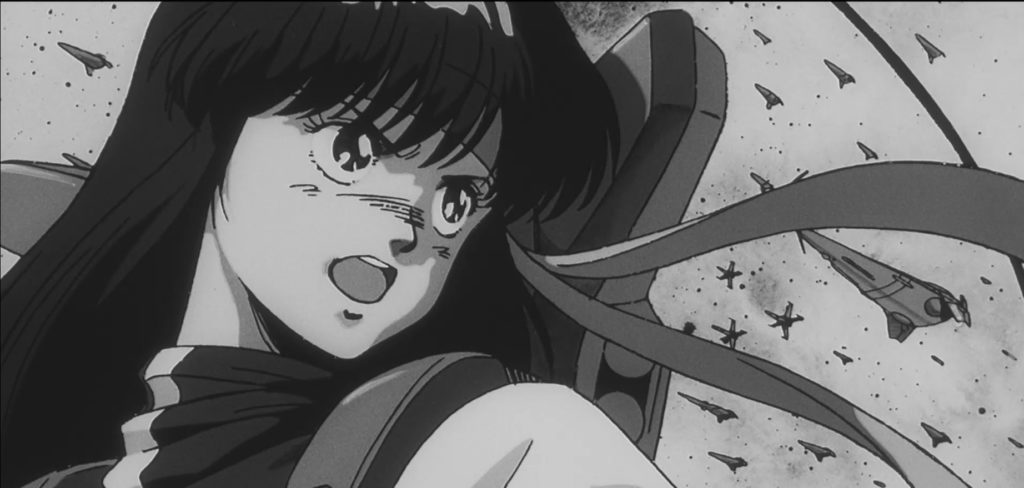Gunbuster Files: Black & White
August 22, 2023 · 0 comments
By Jonathan Clements.

In a bold move that you could only get away with in the days of video, the final episode of Gunbuster is shot in stark black and white, coming across like an old war movie. Depending on which version you’re watching, you might also miss the sudden switch to widescreen… after all, everybody’s telly is widescreen these days.
Toshio Okada wrote in his memoirs that he wanted the episode to be black and white because old-school science fiction felt more futuristic to him, lacking some of the garish colours of 1960s and 1970s sci-fi, which date those films all too easily. He says there was originally a plan to shoot the flashbacks to Noriko’s father in black and white as well, but that fell through.

Gunbuster’s sudden switch to monochrome is hence deliberately evocative of shows like Eightman and Ultra Q, and also of old movies. One in particular that comes to mind as a class of children visit their teacher for the last time, is 24 Eyes, which is a film about a teacher who for various reasons, ends up teaching the same class at different points in their lives, so she sort of time travels through their growth into adults. And it’s a film about the sacrifices made by women, particularly in wartime, and in 1954, which was the year of both Godzilla and the Seven Samurai, 24 Eyes was the most popular film in Japan. So, while those other films get all the foreign attention, 24 Eyes is just as evocative of the Japanese zeitgeist.
The title of this episode evokes Sakyo Komatsu’s 1965 story At the End of the Endless Stream, in which time-travellers flee a dying Earth by retreating into the past. There are in fact several references to the work of Komatsu in this episode – he is best known for Japan Sinks, the ultimate Japanese disaster novel, recently adapted into an anime by Masaaki Yuasa. Shortly after Gunbuster, Gainax would work on a little-known anime series called the Sakyo Komatsu Anime Theatre, adapting 25 of his stories into five-minute shorts.

But sharp-eyed viewers may also notice, for example, that one of the adverts we see in the cable car is for Aerial City 008, which was a puppet show, really one of Japan’s answers to Thunderbirds, from the 1960s, based on a story by Sakyo Komatsu. Back in 1969. 008 was regarded as a failure, because it was thought that Japanese children couldn’t really relate to puppet science fiction, but clearly someone at Gainax loved it.
This is also the first time that we hear mention of Project Carneades, a reference that goes to the heart of Gunbuster. Carneades was a man from North Africa (214 to 129 BC), one of the academic sceptics in Hellenistic philosophy, who was famous for a very tough line on the nature of justice. He is most famous for his commentary on what is known as the Plank of Carneades, which is a question of what would happen if two shipwrecked sailors fought over a plank of wood. Only one of them can survive, so sailor A kills sailor B. When sailor A is rescued by another ship, Carneades asks, is it just to put him on trial for murder, when it was a matter of life and death that he hung onto that plank?

Carneades instead argued that this murderous act, however terrible, might instead be regarded as an act of self-defence. And I think you can see how that rhetoric lends itself to the awful position in which humanity finds itself in this anime. Later in life he would argue with the Romans that justice was inevitably problematic as a concept, and was more to do with running a society than delivering what was truly right. Before he died, he became very bitter about the fact that he was going blind, and once asked: “why does nature undo what she herself has done.” As you can see, another oblique reference to the plot of Gunbuster.

Toshio Okada said that there had originally been a plan to switch to colour when the final battle began, but director Hideaki Anno does have a penchant for going minimalist when everyone expects maximalist. As a result, the climactic battle in Gunbuster switches to rostrum-camera stills work, leavened with a few in-camera effects. I have counted through the images in this sequence, and there are no more than 50 of them. If you were running them through a camera as limited animation, in the style of Astro Boy, then they would take about six seconds, but here they have been judiciously stretched over almost a minute. And these are not cheap little sketches, they are beautifully detailed drawings, and the subject matter is exploding worlds, to the extent that they’re almost saying the human eye can’t really comprehend this, so we are going crude.
But that just leaves us with the ultimate irony, after all is said and done, after millions of lives have been lost and ruined, the Buster Machine 3’s slave generators are not fully operational. There is not enough power of force or mass, or whatever it is that will tip Buster Machine 3 over the edge into a black hole, and that means that it’s all been for nothing. And this is a fantastic evocation of the abyss between very, very large and very, very small, because now it’s all going to come down to two girls in a single spaceship, determining the fate of the entire human race.
Jonathan Clements is the author of Anime: A History. Gunbuster is released in the UK by Anime Limited.
Leave a Reply